American Broadcasting Company (1973-1986, 1993-1996), Buena Vista Home Video (August 27, 2002), 2 disc set, 283 mins plus supplements, 1.33:1 original full screen ratio, Dolby Digital, Not Rated, Retail: $19.99
Storyboard:
Schoolhouse Rock! was a series of musical shorts that both entertained and educated children and adults ever since their creation in the 1970s. They focused on topics ranging from arithmetic to grammar and were wildly popular in both classrooms and living rooms across the country.
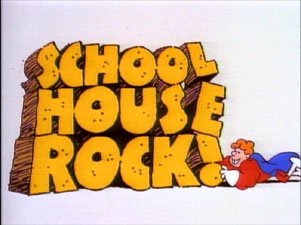
The Sweatbox Review:
In 1972, in a dude ranch in Wyoming, David McCall, an advertising executive at McCaffrey & McCall Advertising, paid close attention to one of his sons who was singing Rolling Stones and Grateful Dead songs. At the time, this same son was having problems memorizing his multiplication tables. David put two and two together and decided that it would be great to put rock music to teach kids math. When he returned to New York, he asked Bob Dorough to write a rock song using the multiplication tables. The first song was entitled “Three is a Magic Number.” It was meant to eventually become an educational phonograph record, but a designer named Tom Yohe heard the song and noticed that it had very visual lyrics. He came up with visual designs to the song and proposed animating it. He drew storyboards and Radford Stone arranged a meeting with Michael Eisner, then Vice President of Children’s Programming at ABC, who was the agency’s biggest client. ABC had been looking for some educational children’s animation, and when Chuck Jones recommended the idea, Eisner closed the deal in that same meeting. This is how Schoolhouse Rock was born.
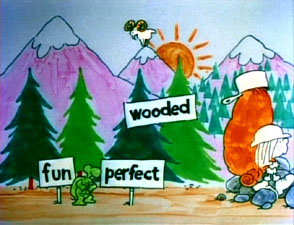
Schoolhouse Rock was broadcast on Saturday mornings on ABC between 1973 and 1985. They would also come back for five more years in the 1990s. The songs were meant to teach children on a variety of topics. The series would take their time since animators worked on it when they were not working on commercials at the advertising agency. Essentially, the cartoons were fillers for more important work, and only a handful of three-minute shorts came out every year. This did not mean that Schoolhouse Rock was not important on television. It had its own advertisers and was even listed on TV Guide. It would even go on to win four Emmy Awards for Outstanding Children’s Television Programming. Over the years, they would educate children on grammar, multiplication, science, money, and American history.
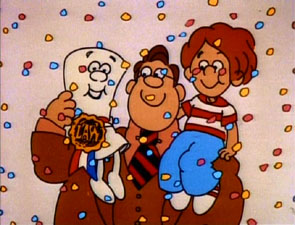
The series used catchy music, simple animation, and repetition to teach children. Studies even showed that the show was unlike many other educational shows because the children actually learned the lessons that were taught. The show became so successful, that many of these children, now grown up, can still remember the lyrics to the different songs. I know that every time my teacher would try to teach my class about conjunctions, the lyrics to “Conjunction Junction” would then play out in my head over and over again. The lessons on civics are also not easily forgotten and many people claim that the only reason they passed their civics test was because they had the words from “The Preamble” stuck in their heads. Even people who applied for American citizenship were encouraged to go out and rent the video America Rock to learn about such complex matters as how a bill becomes a law, which was fabulously explained in “I’m Just a Bill.”
Now, thirty years later, a collection of all of the Schoolhouse Rock songs have finally made their way to DVD. They had been previously released in five video sets: Grammar Rock, Science Rock, Money Rock, Multiplication Rock, and America Rock. These sets have been used in classrooms and even college courses around the country for many years. The DVD includes all original forty-six animated songs, four never-before-released songs, an all-new song entitled “I’m Gonna Send Your Vote to College,” and many extras. The result is a very impressive collector’s edition of this great cartoon show. This new DVD set will really be able to teach a whole new generation that knowledge really is power.
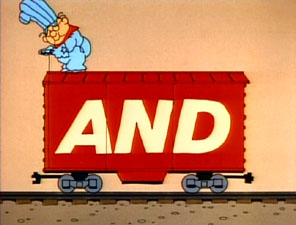
The first disc includes the forty-six original Schoolhouse Rock songs. It begins with a great Schoolhouse Rock introduction (in the Conjunction Junction Diner) that features many of our favorite characters. There is a narrator that tells us what the different areas include. The Play List is divided into seven parts. These include the five different categories that the songs fall in: Grammar Rock, Science Rock, Money Rock, Multiplication Rock, and America Rock. Then, there is the “Top Ten Jukebox”, the “I’m Gonna Send Your Vote to College” song, and “The Whole Enchilada” which allows you to watch all of the songs either in order (“Mild”) or shuffled around (“Spicy”). The “Top Ten Jukebox” option allows you to place the top ten songs in the order that you want to hear them in. The top ten choices are : “Conjunction Junction”, “I’m Just a Bill”, “Lolly, Lolly, Lolly Get Your Adverbs Here”, “Electricity, Electricity”, “Interjections”, “The Preamble”, “Three is a Magic Number”, “Interplanet Janet”, “A Noun is a Person, Place or Thing”, and “The Shot Heard ‘Round the World.”
Grammar Rock
The first section that is featured is Grammar Rock. You can either play them all in order, or you can select them individually. This section features nine different songs. These are probably among the most popular ones. The nine songs are: “Unpack Your Adjectives”, “Lolly, Lolly, Lolly Get Your Adverbs Here”, “Conjunction Junction”, “Interjections!”, “Rufus Xavier Sarsaparilla”, “Verb: That’s What’s Happening”, “A Noun Is A Person, Place or Thing”, “Busy Prepositions”, and “The Tale of Mr. Morton.”

The most popular of these songs, and the most popular Schoolhouse Rock song, is “Conjuction Junction.” Written by Bob Dorough, and sung by Jack Sheldon, the song shows what happens at Conjunction Jct. where a railroad man is explaining the use of conjunctions (the ones that get most of the job done are “and”, “but”, and “or.”) using railroad cars. This is a very entertaining short and the animation is very good. This is the first song that Jack Sheldon sung in and he would become the most known voice in the Schoolhouse Rock series. Animator Phil Kimmelman talks about how he had to make the train animation very limited and so he designed the slow-motion movements of the trains that fit the song very well.
Another highlight from this group of songs includes “Lolly, Lolly…” where they teach children about adverbs and their uses. With the very whinny voices of the singers, this is one of the most memorable songs and I still cannot get it out of my head. The creators decided to speed up the voices to sound more like The Chipmunks. The song is very simple, but the use of repetition is very well-done and the concept is very well-planned out. It shows a store, named Lolly’s Inc., run by “father, son, and Lolly” where they supply adverbs for free.
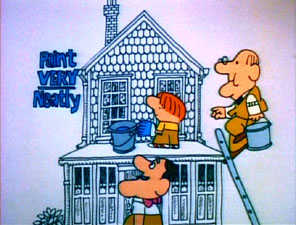
“Interjections!” is also a very great song. With very simple and non-existent backgrounds, the animation combines with the music very effectively. Written by Schoolhouse Rock regular, Lynn Ahrens, the song is very catchy. It features three different stories and how the three use interjections such as “Darn!”, “Hurray!”, and “Ouch!”. Some interesting facts from this short can be found in the audio commentary (on the second disc). Little Reginald from the beginning is actually Tom Yohe Jr. Tom Yohe also featured two of his other children in this song. His song exclaims Rats!, and his daughter finishes with the “Darn! That’s the end!”
“Unpack Your Adjectives” plays in the background to the menu and the short is also very good with a clever use of animation combining with the music as the girl says the words and they appear on the screen. “Rufus Xavier Sarsparilla” is one of the funniest songs that teach us the way that we can exchange the use of long words such as “Rufus Xavier Sarsparilla”, “Kangaroo”, “Rafaella Gabriella Sarsparilla”, “Aardvark”, “Albert Andreas Armadillo”, and “Rhinoceros” with pronouns such as him, her, it, and ours. It is very funny to watch the singer singing all of the complicated lyrics and then simply replacing them with pronouns that will not wear him down. “A Noun is a Person, Place or Thing” is Lynn Ahrens’ first song. She had been working as a secretary at the agency when the Schoolhouse Rock people invited her to play her guitar for them. She told them that she loved writing songs, so they hired her to write one for them. This short includes some inside jokes that would be prevailing in other shorts (the corner of Hudson Street is Ahrens’ street and Shawn Street is named after another worker at the agency). It also features some ingenious animation and has the 1970s feel with the colorful rainbow colors. The creators even talk about how this is one of the times they used their characters running off to the horizon while the song was still ending.
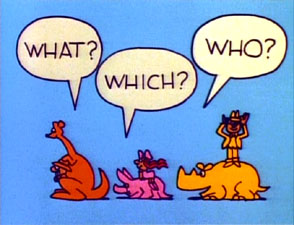
Science Rock
Science Rock includes eight cartoons: “The Body Machine”, “Do the Circulation”, “Electricity, Electricity”, “The Energy Blues”, “Interplanet Janet”, “Telegraph Line”, “Them Not-So-Dry Bones”, and “A Victim of Gravity.” The menu features the song from “The Energy Blues.” This collection features two of the top ten cartoons and really shows how the energy crisis of the 1970s affected the writers, since two of the songs talk about conserving energy or electricity.

“Electricity, Electricity” is one of the best in this collection. With the repetitive chorus singing “Electriticy, eeeeeeee-lectricity” and with the flickering of the word “electricity” it manages to stay in your mind. The Bob Dorough rock song is successfully performed by Zachary Sanders and his chorus of girls. It is funny to hear how sometimes the writers had to deal with rapidly spoken parts because there was so much information to relay in three minutes. “Energy Blues” is the other energy-conscious song that features the Earth singing about how it feels that it is running out of energy. It shows the different ways that energy is obtained, how it all started, and how children can help their parents save on their electricity bills. With the unmistakable voice of Jack Sheldon, this blues song can be very slow and very fast at times (usually in the fast-spoken parts).
There are two other songs worth mentioning in this set. “Interplanet Janet”, written and performed by Lynn Ahrens, features Interplanet Janet “a galaxy girl, a solar system miss from a future world” who travels like a rocket seeing all of the planets. It shows her traveling to the different planets of our Solar System (starting at the Sun) in order. Some inside jokes in this cartoon include the man with a kite on Earth who is a caricature of David McCall, the man who first suggested the idea for the series. The backgrounds are rich and colorful in this cartoon and really show the variety of styles that could be used in this series. The other short is “Telegraph Line” which demonstrates the wonderful use of analogies in the Schoolhouse Rock show. Here, telegrams are used as an analogy for the central nervous system. This cartoon was even used by the pre-med course at the NYU Medical School.

Money Rock
This section features eight cartoons: “Dollars and Sense”, “$7.50 Once A Week”, “Where the Money Goes”, “Tax Man Max”, “Walkin’ On The Wall Street”, “This For That”, “Tyrannosaurus Debt”, and “The Check’s In The Mail.” All of these cartoons deal with the complex issues of economy and spending. It deals with allowance, bills, taxes, investing, loans, debt, barter, and writing checks. I found these cartoons very entertaining but more complex that those in the other collections. Children will mostly learn how they should control their money, and understanding what their parents spend money on.
“Tyrannosaurus Debt” is one of the best in this series and it starts out with a tour of Washington DC with the national debt (in the form of a Tyrannosaurus Rex) standing above the Capitol. It successfully depicts how the debt started and how it will just keep growing (it has an awesome appetite you see?), and it is funny to see little Bill standing on the steps of the capitol at the end. “The Tax Man” teaches kids about what taxes are for, and “Where The Money Goes” shows kids where their parent’s money goes. The most practical one for children is really “$7.50 Once a Week” where they talk about how children should manage their allowance more effectively.
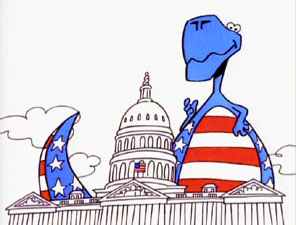
Multiplication Rock
There are eleven cartoons that deal with the multiplication of numbers: “My Hero, Zero”, “Elementary My Dear” (multiplying 2s), “Three is a Magic Number”, “The Four-Legged Zoo”, “Ready Or Not, Here I Come” (multiplying 5s), “I Got Six”, “Lucky Seven Sampson”, “Figure Eight”, “Naughty Number Nine”, “The Good Eleven”, and “Little Twelvetoes.” They multiply all of these numbers from two to twelve. The only multiplication tables not included here are multiplying ones and tens, which are really simple and most children already know those.
The most inspired songs in this set are “Three is a Magic Number”, and “Figure Eight”. “Three is a Magic Number” was the first song in the Schoolhouse Rock series and it is a really soft song. It shows all of the different ways that things are grouped in threes and then goes on with the multiplication table. This is one of the ten favorite songs and it is easy to see why since the animation is really unique when they keep adding things in threes. “Figure Eight” is played in the menu’s background, and the song is sung by jazz singer Blossom Dearie. It is a wonderful soft song that features a great combination of a piano and a cello. Dearie’s voice is soft and soothing. The animation follows the story of a girl in math class who is trying to apply multiplying eights using analogies. The illustrations are very clever, and the girl imagines the number eight that she can skate on ice.
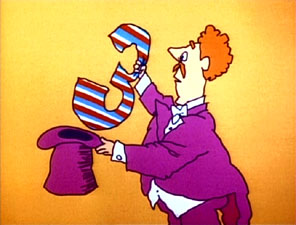
America Rock
With the upcoming bicentennial of the American Independence, the creators of Schoolhouse Rock began to focus on different aspects of American history and government for their cartoons. The ten cartoons included here are: “No More Kings”, “Fireworks”, “The Shot Heard ‘Round the World”, “The Preamble”, “Elbow Room”, “The Great American Melting Pot”, “Mother Necessity”, “Sufferin’ Till Suffrage”, “I’m Just a Bill”, and “Three-Ring Government”. These cartoons are very patriotic and they successfully manage to teach children about American history and government.
“The Preamble” is one of the most memorable songs. It talks about the Preamble of the Constitution of the United States (you know… “We the people…”). The Lynn Ahrens song is very easy to follow and the animation follows Americans throughout the centuries as they sing about it. It is funny to see the same lines with different animation, by George Cannata, in the background. Pay close attention to the ballot in the future where you will find many of the Schoolhouse Rock regulars’ names. George Newall says that his favorite cartoon is “The Great American Melting Pot”. It is easy to see why. The song deals with a tired cliché and makes it unique with a literal melting pot, shaped like the United States, whose ingredients include all of the different nationalities. Yohe’s designs are very good and the colors are sepia toned. Some more inside jokes are included such as a smokestack that reads “Yohe” and a company named “Newall Tool Company”. It is a great song that celebrates the diversity of the USA.

“I’m Just a Bill” is one of the most known Schoolhouse Rock songs and TV Guide even named Bill the 34th greatest cartoon character of all time. Written by Dave Frishberg, and brought to life by the voice of Jack Sheldon, the song tells the story of how a bill becomes a law. The little boy is the voice of Frishberg’s son. This cartoon is a success because it manages to tell a very complex process in a very simple way. The creator’s experience with advertising no doubt helped them achieve this task. Bill’s uncertainty as to whether he will become a law is very fun to watch and when he finally becomes a law it is hard not to smile with his happiness. The show’s popularity even caused it to be spoofed on The Simpsons.
I’m Gonna Send Your Vote To College
“I’m Gonna Send Your Vote to College” is the 48th Schoolhouse Rock song and it was made in 2001. It features the basic premise of how everyone who graduates from this college becomes the president. The music is by George Newall, and it is sung by Bob Dorough and Jack Sheldon. Animators Phil Kimmelman and Bill Peckman have done a great job at bringing it to life. Personally, I am very glad that they did not try to mention the 2000 election recount since it makes it more timeless (unless they someday change the system). The design is in tune with all past Schoolhouse Rock songs and the designer is Tom Yohe’s son, Tom Yohe, Jr. Tom Yohe, Jr. had previously done the design for the grammar song entitled “The Tale of Mr. Morton.”

Is This Thing Loaded?
You can watch the top twenty cartoons shuffled around on the second disc, as well as “I’m Gonna Send Your Vote to College.” As mentioned previously, you can listen to the audio commentaries for ten of these cartoons. There are three never-before-released on video cartoons featuring Scooter Computer and & Mr. Chips. These three cartoons deal with Scooter and his computer and how computers work. The three cartoons are “Software”, “Hardware”, and “Number Crunchers” and they feature Schoolhouse Rock’s only recurring characters. Another cartoon that you will not find anywhere else is the long-lost song “The Weather Show” which is a delightful cartoon that educates about the weather.
There are also some live-action featurettes, which include an Emmy Awards Featurette, the Making of “I’m Gonna Send Your Vote to College” introduced by Michael Eisner, and a Nike TV Spot featuring “Three is a Magic Number.” These featurettes are fun to watch, and the “making of” is a really informative segment that talks about the origins of the series. It features interviews with many of the makers that were around to make the latest cartoon in the recording studio. There are also three music videos with four Schoolhouse Rock Songs sung by contemporary artists (“I’m Just a Bill”, “Conjunction Junction”, “My Hero, Zero”, and “Electricity, Electricity”).
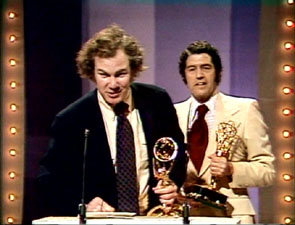
There are also two games in the DVD. There is an “Arrange A Schoolhouse Rock Song” with three different levels: Elementary, Jr. High, and Sr. High. You must know the sequence of events in your favorite Schoolhouse Rock songs to pass, but if you pay attention to the small clips, you can piece the puzzle together. The “Earn Your Diploma” feature has a quiz regarding the different cartoons (not all are educational questions, but details from the cartoons). I sometimes found the quiz hard, but there is a special treat for those who successfully complete all of the quizzes. A narrator provides some interesting trivia about the questions.
Case Study:
The case for this release is a standard two-disc case. On the cover, you will find Bill and the railroad man from “Conjunction Junction”. On the back is a list of the main features and a summary of what is included. Inside the case is an extensive booklet that features a simple navigational guide, an interview with George Newall, lyrics to the top ten Schoolhouse Rock songs, a chapter index, and the lyrics to the new song, “I’m Gonna Send Your Vote To College.”

Ink And Paint:
The entire set is featured in the original full screen (1.33:1) format. The older cartoons do feature some grains and scratches, but the new ones are clean. The cleanup that they have gone through is good, but the really old ones look very different. However, the cartoons still look great and colorful as they have ever been.
Scratch Tracks:
Schoolhouse Rock is being released with a standard Dolby Digital track. “I’m Gonna Send Your Vote to College” can be played in both English DTS 5.1 Surround or in English Dolby Digital 5.1 Surround. There are no foreign languages available, but there are English captions available. There is an audio commentary available for “Lolly…”, “Great American Melting Pot”, “Telegraph Line”, “Figure Eight”, “Interplanet Janet”, “Conjunction Junction”, “I’m Just a Bill”, “The Preamble”, “Interjections!”, and “A Noun Is A Person, Place or Thing” on the second disc.

Final Cut:
Schoolhouse Rock is another great television cartoon series to own on DVD. These cartoons have made a great impact on children in the past three decades and I am sure that they will continue this for years to come. The songs are entertaining, catchy, and feature original animation concepts and designs. The songs are guaranteed to stick in your head long after you have stopped watching them. Your head almost becomes like the jukebox featured in the beginning of the intro and you think of a different song that immediately takes over and they are all equally powerful. Not all of the cartoons are that great, but the ones that are good definitely make their mark. More than that, they also manage to teach us a great deal about grammar, multiplication (I think I finally got the 8s), science, money (I can write checks now), and American History.
 | ||
 |









